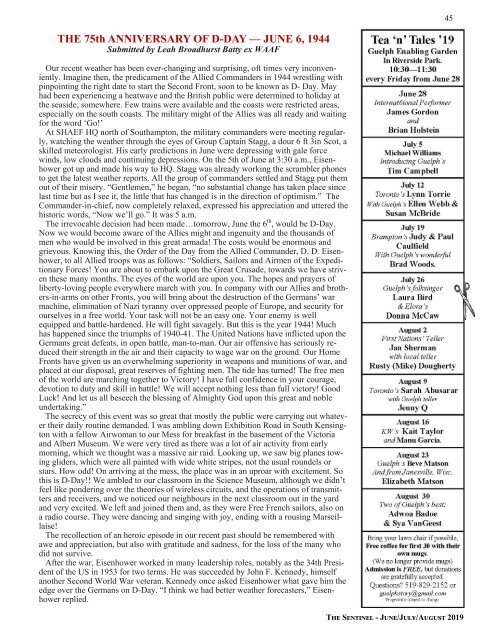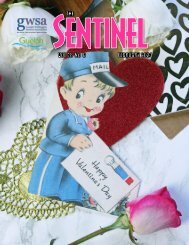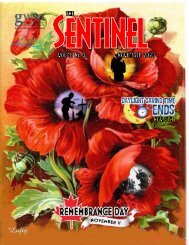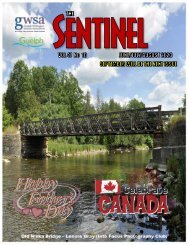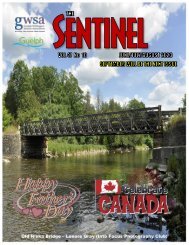Create successful ePaper yourself
Turn your PDF publications into a flip-book with our unique Google optimized e-Paper software.
45<br />
THE 75th ANNIVERSARY OF D-DAY — JUNE 6, 1944<br />
Submitted by Leah Broadhurst Batty ex WAAF<br />
Our recent weather has been ever-changing and surprising, oft times very inconveniently.<br />
Imagine then, the predicament of the Allied Commanders in 1944 wrestling with<br />
pinpointing the right date to start the Second Front, soon to be known as D- Day. May<br />
had been experiencing a heatwave and the British public were determined to holiday at<br />
the seaside, somewhere. Few trains were available and the coasts were restricted areas,<br />
especially on the south coasts. The military might of the Allies was all ready and waiting<br />
for the word ‘Go!’<br />
At SHAEF HQ north of Southampton, the military commanders were meeting regularly,<br />
watching the weather through the eyes of Group Captain Stagg, a dour 6 ft 3in Scot, a<br />
skilled meteorologist. His early predictions in <strong>June</strong> were depressing with gale force<br />
winds, low clouds and continuing depressions. On the 5th of <strong>June</strong> at 3:30 a.m., Eisenhower<br />
got up and made his way to HQ. Stagg was already working the scrambler phones<br />
to get the latest weather reports. All the group of commanders settled and Stagg put them<br />
out of their misery. “Gentlemen,” he began, “no substantial change has taken place since<br />
last time but as I see it, the little that has changed is in the direction of optimism.” The<br />
Commander-in-chief, now completely relaxed, expressed his appreciation and uttered the<br />
historic words, “Now we’ll go.” It was 5 a.m.<br />
The irrevocable decision had been made…tomorrow, <strong>June</strong> the 6 th , would be D-Day.<br />
Now we would become aware of the Allies might and ingenuity and the thousands of<br />
men who would be involved in this great armada! The costs would be enormous and<br />
grievous. Knowing this, the Order of the Day from the Allied Commander, D. D. Eisenhower,<br />
to all Allied troops was as follows: “Soldiers, Sailors and Airmen of the Expeditionary<br />
Forces! You are about to embark upon the Great Crusade, towards we have striven<br />
these many months. The eyes of the world are upon you. The hopes and prayers of<br />
liberty-loving people everywhere march with you. In company with our Allies and brothers-in-arms<br />
on other Fronts, you will bring about the destruction of the Germans’ war<br />
machine, elimination of Nazi tyranny over oppressed people of Europe, and security for<br />
ourselves in a free world. Your task will not be an easy one. Your enemy is well<br />
equipped and battle-hardened. He will fight savagely. But this is the year 1944! Much<br />
has happened since the triumphs of 1940-41. The United Nations have inflicted upon the<br />
Germans great defeats, in open battle, man-to-man. Our air offensive has seriously reduced<br />
their strength in the air and their capacity to wage war on the ground. Our Home<br />
Fronts have given us an overwhelming superiority in weapons and munitions of war, and<br />
placed at our disposal, great reserves of fighting men. The tide has turned! The free men<br />
of the world are marching together to Victory! I have full confidence in your courage,<br />
devotion to duty and skill in battle! We will accept nothing less than full victory! Good<br />
Luck! And let us all beseech the blessing of Almighty God upon this great and noble<br />
undertaking.”<br />
The secrecy of this event was so great that mostly the public were carrying out whatever<br />
their daily routine demanded. I was ambling down Exhibition Road in South Kensington<br />
with a fellow Airwoman to our Mess for breakfast in the basement of the Victoria<br />
and Albert Museum. We were very tired as there was a lot of air activity from early<br />
morning, which we thought was a massive air raid. Looking up, we saw big planes towing<br />
gliders, which were all painted with wide white stripes, not the usual roundels or<br />
stars. How odd! On arriving at the mess, the place was in an uproar with excitement. So<br />
this is D-Day!! We ambled to our classroom in the Science Museum, although we didn’t<br />
feel like pondering over the theories of wireless circuits, and the operations of transmitters<br />
and receivers, and we noticed our neighbours in the next classroom out in the yard<br />
and very excited. We left and joined them and, as they were Free French sailors, also on<br />
a radio course. They were dancing and singing with joy, ending with a rousing Marseillaise!<br />
The recollection of an heroic episode in our recent past should be remembered with<br />
awe and appreciation, but also with gratitude and sadness, for the loss of the many who<br />
did not survive.<br />
After the war, Eisenhower worked in many leadership roles, notably as the 34th President<br />
of the US in 1953 for two terms. He was succeeded by John F. Kennedy, himself<br />
another Second World War veteran. Kennedy once asked Eisenhower what gave him the<br />
edge over the Germans on D-Day. “I think we had better weather forecasters,” Eisenhower<br />
replied.<br />
T S - J/J/A <strong>2019</strong>


